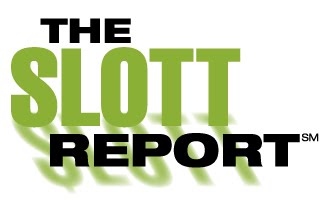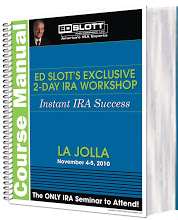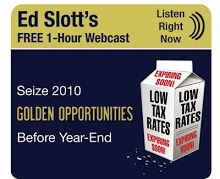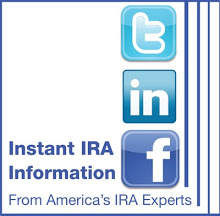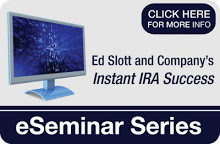Thursday, July 30, 2009
Slott Report Mailbag: July 30th
1.
After reading your book, "The Retirement Savings Time Bomb", I had decided to convert my IRA to a Roth in 2010. I'm 61 years old and retired. Because of Sub S income I still exceed the 100,000 income limit that excludes me from converting prior to 2010.
Now I hear that Congress is planning to pass the health care bill and fund it by charging a surtax on individuals that make over 1,000,000. This will go into effect at least by 2010 and kill the Roth conversion option that I am sure many Americans were planning to use. Do you know
any detail of the surtax being considered?
Jack Eggspuehler
Ida Grove, IA
Answer:
Jack --
There are several surtax options being considered to help finance the new health care bill if passed. At this point however, we haven't seen anything that will effect traditional IRA conversions. As it stands now in 2010, the $100,000 modified adjusted gross income limit will be permanently repealed and also married individuals filling separate tax returns will be able to convert to a Roth IRA.
2.
My Dad died at 86 in May and had been taking RMD since age 70 1/2. The Credit Union is willing to do a trustee to trustee transfer to my bank to open a new inherited IRA. After I set up new inherited IRA account, when do I need to start taking distributions (I'm 45)?
Mom died 8 months ago, her small IRA had NO designated beneficiary. I assume this has to be probated and want to know who owns this IRA after probate is completed. My parents had a Living Trust. I am the successor trustee.
Thanks!
Answer:
After the death of an IRA owner, the beneficiaries must start taking required minimum distributions (RMDs) a year after death of the deceased owner. The RMDs from a traditional IRA will be income taxable and from a Roth IRA it will be tax free. In 2009, and only 2009, RMDs are suspended so no RMDs will have to be taken if you don't need the money.
Commencing in 2010 you will have to take RMDs based on your attained age a year after your dad's death. If your attained age is 46 your single life expectancy factor will be 37.9 years. All beneficiaries are required to use the single life expectancy table found in IRS publication 590.
In your mother's case, you should consult the IRA custodian or trustee to determine the default language in the IRA document to determine the default beneficiary because no designated beneficiary was named in the designation of beneficiary form.
3.
If I convert part of my traditional IRA next year to a ROTH and then pass away before the
5 years are completed for tax free withdrawal by a beneficiary, how does that effect the beneficiary's withdrawals?
Todd Gilbert
Answer:
The five year rule applies, assuming you are age 59 1/2 or older, to the earnings on the converted amount. You or your heirs can always take out the principal amount converted without penalty. For example, if you convert $50,000 to a Roth IRA the entire $50,000 can be withdrawn without penalty. If the Roth IRA is now $55,000 any amount taken out over the $50,000 would have to have been in the Roth IRA for five years. Money coming out of the Roth IRA is always considered the converted amount first.
4.
Hi,
I am almost 60 years old. I expect to continue to work unless illness or death takes over. I have been contributing to a mandatory state retirement plan in Massachusetts for 10 years. I also have a retirement from MIT for 14 years when I worked there. I am a renter. I expect to be purchasing a home in the next two years. What are your thoughts on starting a Roth IRA at this time of my life. Am I going to be forced to take a retirement though I want to continue to work?
What do you think?
Sincerely,
David J. Wilson Sr.
Answer:
Your current age should not be a deterrent in establishing a Roth IRA. Number one, we think income tax rates will be going up in the future. Distributions from a Roth IRA are tax free. Number two, you will not have to take required minimum distributions at age 70 1/2 from a Roth IRA. And number three, you can continue to contribute, assuming you have earned income, after age 70 1/2.
Wednesday, July 29, 2009
So You’ve Inherited an IRA - What Distributions do you Have to Take?
A non-spouse beneficiary must ALWAYS take a required distribution beginning in the year after the account owner's death. It does not matter how old the account owner was or how old the beneficiary is, the first required distribution is ALWAYS in the year after death. Of course, for 2009 there is an exception since RMDs have been suspended for the year from non-annuitized IRAs and defined contribution employer plans (401(k), 403(b), 457 plans, etc.).
The RMD is calculated based on your age at the end of the year of the first distribution. You look up your age on the IRS Single Life Table to get your life expectancy factor. You can find that table on our website or in IRS Publication 590. For example, a 40-year-old has a life expectancy factor of 43.6. You take the prior year end account balance and divide it by your factor to get the amount of your required distribution. Next year, you will take your factor and subtract one for the factor to use in year 2 (43.6 - 1 = 42.6). Each year you will continue to subtract one and divide the prior year end account balance by the new factor to find the amount of your RMD.
You only have this option if the IRA agreement allows you to stretch distributions. The IRA custodian (or employer plan) is not required to allow this. They may require an accelerated payout schedule. Also, if the account owner died without taking their own required distribution for the year, you, as the beneficiary, must take any remaining RMD for the account owner.
The penalty for missing a required distribution is 50% of the amount not taken. That is
50%.
And you owe income tax on the total amount of the RMD. So be sure to take those required distributions.
You can find IRS Publication 590 on their website, http://www.irs.gov/. On the left hand side of the screen click on Forms and Publications.
Tuesday, July 28, 2009
Ed in Investment News: IRS kills 72(t) payment correction request
- The IRS recently ruled that an "improper transfer of funds from an individual retirement account from which the client was taking 72(t) payments triggered the 10% early-withdrawal penalty."
- IRS Private Letter ruling (PLR 200925044) ruled that in attempting to change the IRA investments, the client had altered the 72(t) payment schedule.
- This means -- especially with may clients changing investments and custodians these days -- that advisors must be aware of the special rules that apply when a client takes a series of early withdrawals from an IRA.
- These modifications result in retroactive penalties and interest.
- A series of substantially equal periodic payments (72(t) payments) can help to avoid the 10% early distribution penalty on withdrawals taken before age 59 1/2.
- Those payments must continue for 5 years or until the owner reaches age 59 1/2, whichever period is longer.
- If a client doesn't maintain the schedule -- including changes to the account balance through additions or subtractions other than earning and losses -- a "modification" occurs and the 10% penalty plus interest is applied.
-Article by Ed Slott; synopsis by Jared Trexler
---------------------------------------------------------------------
Comment, Question, Discussion Topic on your mind? Click on the Blue Comment Link below and leave your thoughts then check back to see what other consumers and advisors think.
*Copyright 2009 Ed Slott and Company, LLC
Monday, July 27, 2009
401(k) Plan Loans
In a tough economy, when cash-strapped individuals are looking for a ready source of funds, retirement plans figure as a tempting pot of money.
So far, however, most people have resisted the temptation to withdraw from their retirement accounts, take loans or even mess with their portfolios. In a recent study, researcher Hewitt Associates found that most 401(k) participants didn't change their behavior much in 2008. Just 20% did any trading in their accounts, while 23% took out a loan and a mere 1% pulled out money permanently as hardship withdrawals, figures comparable to prior years.
Most 401(k) plans let you take out a loan. Usually, you face a low interest rate and pay the principal and interest back to your account using after tax dollars. If you leave your job or get fired or laid off, you need to pay back any balance. If you can't, it becomes a taxable withdrawal, with a 10% penalty if you are younger than 59 ½.
Short of making a permanent withdrawal, taking out a 401(k) loan offers a compromise. Workers can access part of their funds without the need to qualify for a loan, as they would with other forms of borrowing. They pay back the money gradually by having it withheld from salary, and face modest interest rates. Principal and interest go back into their accounts, rather than to a bank. However, money in a retirement plan should be used for retirement and only under dire conditions should you consider borrowing from a retirement plan.
The provisions of each 401(k) plan could be different so you want to check with the plan administrator, or check on line, to make sure your 401(k) plan offers a loan provision and you understand all the provisions regarding taking a loan.
-By IRA Technical Consultant Marvin Rotenberg and Jared Trexler
---------------------------------------------------------------------
Comment, Question, Discussion Topic on your mind? Click on the Blue Comment Link below and leave your thoughts then check back to see what other consumers and advisors think.
*Copyright 2009 Ed Slott and Company, LLC
Tuesday, July 21, 2009
Where Ed is Next
CLICK HERE to view Ed's entire speaking schedule. If you want Ed to speak for you, contact Laurin Levine at 516-536-8282.
eSeminar Series Session: The Missing Estate Plan
You can still register for today's 90-minute session as a refresher course, or sign up for all 8 sessions (it satisfies prerequisite for the Elite Group!) and achieve Instant IRA Success!
If you have any questions about the eSeminar Series, ask them via Twitter and Facebook or give us a call at 215-557-7022.
Monday, July 20, 2009
Time Is Of The Essence For Estate Tax Law
Here we are half way through 2009 and Congress has yet to address the Federal estate tax issue. The Economic Growth and Tax Relief Reconciliation Act of 2001 mandates a full repeal of the federal estate tax, and the federal estate tax rate is set to drop to zero from 45% currently, on 1/1/2010.
The tax rate change may not be the most radical thing on the horizon. Existing law also would repeal a rule that offers record keeping simplification and tax relief. It is known as the automatic step-up in “basis”.
Basis is the portion of the value of real estate, stocks or other assets on which capital gain taxes are not due. At the moment, when someone dies, the basis of an asset automatically gets increased, or stepped up to current value, thus eliminating any tax. Congress tried to eliminate the step up in basis in 1976 and it proved to be a total disaster.
Even more chaos is potentially in store, assuming Congress doesn't act. If the law is not changed, that zero tax rate for 2010 would be followed, in 2011, by the reimposition of a 55% estate levy on assets over $1 million, along with a return to automatic basis step up.
In other words, federal law could change dramatically in less than six months, only to revert one year later to roughly where it was in 2001.
It is estimated that less than 2% of estates in the U. S. are subject to estate tax, but that still represents billions of dollars.
Many estate planning experts don't believe Congress and the White House will let matters transpire as mandated. However, they have been predicting Washington would modify the rules well before 2010 and so far nothing has happened. Stay tuned.
-By IRA Technical Consultant Marvin Rotenberg and Jared Trexler
---------------------------------------------------------------------
Comment, Question, Discussion Topic on your mind? Click on the Blue Comment Link below and leave your thoughts then check back to see what other consumers and advisors think.
*Copyright 2009 Ed Slott and Company, LLC
Friday, July 17, 2009
Reminder: eSeminar Series Session Tuesday
To all registrants: You will receive e-mailed instructions on Tuesday morning.
To all other advisors: You can go to the following web address for more info and to register:
http://www.irahelp.com/seminar/registration/
Have a Great Weekend!
Thursday, July 16, 2009
Slott Report Mailbag: July 16, 2009
1.
Dear Mr. Slott and Company:
My father was a teacher who already retired from the Miami-Dade County Public School system. His pension plan is a teachers' pension plan administered by some pension plan company or by the teachers' union. Can he convert it into anything better so that he can leave it to my mom or to his children or grandchildren? He has no idea. He is under the impression that either it will run out when he dies or my mom will continue to receive survivor's benefits. He tends to trust large, impressive-sounding entities & tends to shy away from potentially confusing details.
Furthermore, I saw your PBS show & have since purchased your DVD & 3 of your books. I told my parents that they should redo all of their beneficiary forms, for their life insurance, their stocks, his pension plan, their bank accounts, etc. People keep telling my father that as long as everything is in both spouses' names, it will be alright. However, my father insists that he really does not want to give everything away to the government. Should they or should they not change those beneficiary forms?
People keep telling them to just indicate it in their wills and trusts. I'm telling them to fix the beneficiary forms now. Which way will allow them to shield the maximum amount from the IRS?
Sincerely,
David Masters
Answer:
What you are describing sounds like a 403(b) plan and referred to as a TIAA-CREF plan. If your father has annuitized his benefits, meaning that he is receiving a monthly benefit, probably he will not be able to convert to an IRA. If he is entitled to a lump-sum distribution then perhaps he can roll it over to an IRA. A 403(b) plan has a unique feature in that if the administrator can identify any balance in the plan prior to 1987 that amount does not have to be used in calculation required minimum distributions (RMDs) at age 70 1/2. That amount would be added back starting at age 75. In any event, you should definitely check the designation of beneficiary form. As a general rule, you don't want to pass this asset under a will.
Without knowing your parents' financial status it's difficult to determine how their various assets should be registered. Many times financial planers try to have different assets in each parent's name to equalize the estate. This may or may not be appropriate in this case. You definitely want to check the registration and beneficiary forms on all their assets to insure the assets will be going where they are intended to go. And you will want to do this regularly because things tend to change.
2.
Hello,
I was under the impression that you once a person dies you cannot bypass an IRA (from a grandparent to a grandchild - bypassing the parent) unless they are listed as a contingent beneficiary.
Someone recently told me that they do not have to be listed and that this can be done at the time of the person's death. Can you clarify? If it can be done when the person passes away, what advantages are there to have them listed prior to them passing.
Thank you for resolving this issue,
Suzanne
Answer:
Parents can name any primary or contingent beneficiary they so choose. They can name their children or grandchildren as their primary beneficiary. Or they can name their children as primary beneficiary and the grandchildren as contingent beneficiary. In any event the designation of beneficiary form should be filled out.with the names either as primary or contingent beneficiary.
If there is no designated beneficiary or contingent, or just one not the other, at death you can not then fill them in. In some cases the plan document will default to the estate or perhaps surviving spouse or children. However, generally you don't want that to happen. New beneficiaries can not be added after death.
3.
I am having a bit of a difficulty understanding the timeline with regards to converting a Roth, recharacterizing it back to a traditional, and then being able to convert again. Publication 590 is
not completely clear. Below is the scenario.
December 2008 = $100K from a $1M IRA is converted to a Roth IRA
March 2009 = the client's financial advisor says the market is much lower now, client needs to recharacterize back to Traditional IRA.
That step is taken
April 2009 = CPA completes 2008 tax return and client shows an unusual NEGATIVE taxable income of $78K for 2008
Questions:
(1) Can anything be done to keep that Roth conversion on the 2008 income tax return to take advantage of negative income?
(2) When is the client eligible to convert the assets again to a Roth?
Thank you so much for your help!!
Jennifer Strong
Answer:
If you recharacterized in March of 2009 you are in effect undoing what you converted in 2008. You would not be able to take advantage of a negative income for purposes of converting to a Roth IRA in 2008.
If you wish to convert the same funds that you have just rechacterized you must wait more than 30 days. The rule says that once you convert and then rechacterize, you can not reconvert those same funds until the year after the year of conversion or more than 30 days after the recharacterization, whchever is later.
Tuesday, July 14, 2009
Converting Inherited Assets to a Roth IRA
Yes
Inherited employer plan assets (401(k), etc.) can be directly transferred to a properly titled, inherited Roth IRA. Income tax will be due on the amount converted and must be paid by the beneficiary doing the conversion. Since the funds are in an inherited Roth IRA, required distributions to the beneficiary begin in the year after the plan participant's death. For 2009, the employer plan is not required to offer this option. In 2010 it will become mandatory for the plan to allow a transfer to an inherited IRA or Roth IRA.
No
Inherited IRAs, on the other hand, cannot be converted to inherited Roth IRAs. Only the IRA owner (the person who made the IRA contributions) can do the conversion.
Spouses
A spouse can always move the funds inherited from the deceased spouse to his or her own IRA and then do a conversion to a Roth IRA.
*Copyright 2009 Ed Slott and Company, LLC
Be Our Friend! Help Create the Largest Online IRA Community
We envision Facebook as just another extension of our most important goal: instantaneous IRA information straight to you through a variety of avenues. Our facebook account will post blog updates, workshop and webcast information and the latest e-mail notifications. It will also be one large IRA family, where advisors and consumers can network, join each other's lists and discuss the latest in the IRA community.
Just go to www.facebook.com and sign in (or sign up if you don't have an account) then search for "Ed Slott" and send us a friend request. Once we accepted your request, don't forget to search our friends list so you can try to get in touch with financial advisors or other consumers who share in your goal for more money in retirement...and more of it tax-free!
Monday, July 13, 2009
Roth IRA Losses
If you have lost money in your Roth IRA, you are not alone. We have had three years of a sour stock market, despite a recent modest recovery. If your Roth IRA loses money shortly after you converted from a traditional IRA, your best choice may be to undo the conversion. To undo you would recharacterize by no later than October 15th of the year following the conversion. Then you can elect to convert again the later of January 1st of the year following the year of conversion or 30 days after the rechacterization. Usually the lower value of the account means you will pay a smaller tax on the second conversion.
However, if you cannot recharacterize and want to realize a loss for income tax purposes you must liquidate all of your Roth IRAs. The loss is determined by your basis. Your basis is the amount of your contribution to the Roth IRA, including conversion contributions, reduced by any amounts you have withdrawn. Generally when you sell a stock outside of an IRA for a loss you would be entitled to a capital loss deduction. When you liquidate a Roth IRA for a loss the loss will be a miscellaneous itemized deduction that is subject to the 2 % floor. This means it is an ordinary deduction rather than a capital loss. The deduction is, however, only available if you itemize.
The 2% floor mentioned above means that all your miscellaneous itemized deductions get lumped together and reduced by 2% of your adjusted gross income (AGI). There is another possible drawback. Miscellaneous deductions are not allowed for purposes of the alternative minimum tax (AMT). That means you lose the benefit of the deduction (or some of the benefit) because of the AMT rules.
Here is an example:
You convert a traditional IRA when it is worth $5,000 and now it’s worth $1,500. Your AGI is $90,000. If you liquidate the Roth IRA for a loss of $3,500, you will have to reduce that amount by $1,800 (2% of your AGI), leaving you with a deduction of only $1,700.
Whether it makes sense to liquidate you Roth IRA to claim this deduction depends on many factors. Do you itemize? How large is the loss compared with the 2% of your AGI? How much do you lose by removing what’s left of your account from the Roth IRA, where it has the potential to produce tax-exempt earnings? Will you incur a 10% penalty (prior to age 59 ½) if you liquidate now?
This can be a complicated decision, so you may want to consult with a tax professional before making a decision.
*Copyright 2009 Ed Slott and Company, LLC
Thursday, July 9, 2009
Mailbag: July 9, 2009
We are in the heat (or lack thereof if you live in the Pennsylvania-New York-New Jersey metropolitan area) of summer, and consumers are still worried about a shaky economy and what it means for their retirement as we stumble into the second half of 2009.
We tackle consumer questions and provide answers below.
1.
I have been wondering if an inherited IRA can be converted to a Roth IRA in 2010. I am currently taking RMDs over an approximate 26-year period. The approximate numbers are as follows: current value of the inherited IRA $200,000, unused deduction for income in respect of a decedent $110,000. RMDs were taken in 2007 and 2008. The real question I have is if the IRA can be converted to a Roth could the deduction for income in respect of a decedent be used to offset the taxable income resulting from the conversion? My reasoning is a follows: the asset value of the IRA has been beaten down by the market, tax rates are likely to increase in the future, and over the remaining life of the IRA the asset values in the account will increase in the long haul. If I can offset the conversion income with the deduction in respect of a decedent I should be able to shelter more of the converted assets as the amount of the total deduction of income in respect of a decedent does not change, as it was calculated when the estate tax return was filed and based on the FMV at that time.
Thanks!
Answer:
Under current regulations an inherited IRA can not be converted to a Roth IRA. Therefore, you would continue to use the IRD deduction each year you take distributions until it is used up.
2.
Hi Ed and Company,
A great site and very well done.
My question has three parts:
1- My children are in their 30's & 40's and plan to convert their traditional rollover IRAs to existing or new Roth IRAs next year when the restrictions come off. Your site seemed to indicate that they would be hit with a 10% penalty on top of the income tax owed since they are not 59 1/2. Is that correct? They would simply be transferring the funds directly from one account to another at their existing trustee's firm, never actually withdrawing the funds personally.
2- One child also has a 401-k plan with her employer (also at the same trustee). The site indicated that, depending on the rules for the plan, it might also be possible to convert a portion of the plan balance to a Roth if she were 59 1/2 or had 5 years of service. She has 5 years of service, but since she is not 59 1/2, would this trigger a 10% penalty hit?
3- The one time ability to pay the tax due on 2010 conversions over two years has me confused as it is referred to as "payable in 2011 & 2012" for a conversion in 2010. Does this refer to the income tax due on 4-15-2011 for the tax year 2010 and the tax due on 4-15-2012 for the tax year 2011, or is it actually due on the returns for tax years 2011 & 2012, pushing each payable date an additional year into the future?
Thanks for the help. I think I might want to attend one of your seminars before 2010 rolls around as I am sure there will be other questions by then.
T. Devlin
Answer:
- Your children can convert their IRA rollover to a Roth IRA in 2011 and not be subject to a 10% early distribution penalty. If they elect to take money out of the Roth IRA they would have to be age 59 1/2 in older to avoid the 10% penalty. In addition the Roth would have to be open for 5 years for them to take out any earnings (amount over the converted amount) to avoid a penalty.
- The plan is the law of the land. IRS rules are generally more liberal than corporate plans. It sounds like they are saying that to take money out of the plan without any restrictions you must be age 59 1/2 or older. This is fairly common in corporate plans and generally refers to being able to continue to contribute, and receive any company match, to the plan. They refer to this type of provision as an "in service withdrawal".
- The income tax due on a conversion in 2010 could be spread over two years, 2011 & 2012. So in effect you are skipping the year 2010. It is, however, optional to spread the tax over two years or pay it all in 2010 ( by April 15 of 2011).
3.
Ed and Company,
I really enjoyed reading your book, "The Retirement Savings Time Bomb".
I have a Roth IRA with a lot of basis created by the stock of a company that went bankrupt. I sold the considerable shares in the Roth for pennys and was left with a basis. I have moved some stock from my contributory IRA to this Roth and plan to pay the taxes. May I use the basis (by definition I have paid taxes on this money) that is in the Roth to offset money for money the value of stock converted over from the contributory IRA? May I capture the basis this way? I did not elect to take the tax loss by closing out my only Roth.
Sincerely,
Roger and Julie Blevins
Answer:
Basis is created by putting money in a non-deductible IRA from a contribution to a Roth IRA, or after tax dollars in a corporate plan. The fact that a company held in your IRA went bankrupt does not create basis. You would have paid income tax on the conversion, which would include the value of that company stock at the time of conversion. If it was bankrupt at that point it would have had no or little value.
Wednesday, July 8, 2009
Check In...Before It's Too Late
As a consumer, perhaps you decided to forgo a payout to give your account time to recover and rebuild in a tough economy. However, did you notify the company that holds your nest egg.
Because through the first half of 2009, many companies were still awaiting federal guidance on the Worker, Retiree and Employer Recovery Act of 2008 (an act that has been detailed in this space, in Ed Slott's IRA Advisor Newsletter and in e-mails to our Elite members).
The law suspended required minimum distributions from certain retirement accounts -- 401(k)s, 403(b)s, and government 457's -- for 2009. However, the IRS issued little further guidance, so retirement plans came up with several differing interpretations of the one-year RMD hiatus.
The best way to know what is going on with your account? Communicate.
- Get in touch with the company that holds your nest egg and see how they are treating distributions this year.
- Ed Slott makes an important point; "You have 60 days to return a distribution or roll it into another pre-tax account." If you don't do either -- it is taxable.
CLICK HERE to read the article in its entirety.
-By Jared Trexler
---------------------------------------------------------------------
Comment, Question, Discussion Topic on your mind? Click on the Blue Comment Link below and leave your thoughts then check back to see what other consumers and advisors think.
*Copyright 2009 Ed Slott and Company, LLC
Tuesday, July 7, 2009
eSeminar Series Session #5
As an overview, each of the 8 sessions lasts approximately 90 minutes and includes Q&A with our IRA technical consultants. These webcasts are AUDIO ONLY, and we have dates running through August 2010.
If you take all 8 sessions -- and pass the quiz at the end of each session -- you are eligible to join Ed Slott's Elite IRA Advisor Group. And remember, if you are coming upon this new online program for the first time, you can always make up the 4 sessions you missed on one of their other dates -- REMEMBER WE HAVE DATES RUNNING THROUGH AUGUST 2010.
You can go to http://www.irahelp.com/ for more information and to register.
Also, as a side note, don't forget to go to http://www.twitter.com/, sign up and follow The Slott Report on a daily basis as we send you email notification alerts, blog updates, article links and more. You really can follow America's IRA Experts in real time.
--By Jared Trexler
IRA Contributions
I got an email last week that prompted this blog. It is not the first time I have come across this set of circumstances. A college student, who is a beneficiary of an IRA, was taking her RMDs from the inherited IRA. Then, as instructed by her advisor, she was making $5,000 contributions to her own IRA from the RMD funds. The new advisor she had consulted was concerned that she was not eligible to make these IRA contributions.
In order to make an IRA contribution, you have to have “earned” income. Retirement plan distributions are not considered earned income. This includes 401(k), 403(b), pension, IRA, and annuity distributions. The safe harbor is W-2 income.
It is possible that the college student beneficiary has a part time job while she is attending college. As long as she is earning at least $5,000 a year, she can make a $5,000 IRA contribution from any funds she has available. If she is earning less than $5,000, she can make a contribution up to the amount of her earnings.
If she has no earnings, then she is not eligible to make any contribution. In that case, she has excess contributions to her IRA which should be removed. Excess contributions that remain in the IRA are subject to a 6% penalty for each year that they remain in the IRA as an excess contribution.
-By IRA Technical Consultant Beverly DeVeny and Jared Trexler
---------------------------------------------------------------------
Comment, Question, Discussion Topic on your mind? Click on the Blue Comment Link below and leave your thoughts then check back to see what other consumers and advisors think.
*Copyright 2009 Ed Slott and Company, LLC
Monday, July 6, 2009
The 5-Year Rule
Applicability of the so called "5-year rule" is one of the most misunderstood and error prone areas of all the IRA distribution rules. Many institutions apply a 5-year rule on distributions. The IRS has a 5-year rule that applies to IRAs and that is distinctly different than a 5-year rule applied by institutions. The 5-year rule mandates that the entire balance of an IRA must be withdrawn by no later than the end of the year containing the IRA owner's fifth anniversary of death.
Under the distribution rules regulations the 5-year rule only applies when the IRA owner dies before his/her required beginning date (RBD), which is April 1st of the year following their 70 ½ birthday, with no living individuals as named beneficiaries. A non-living entity would be a non-qualifying trust, charity or estate. All of which do not have a life in being. In all other cases, the only way you would be subject to the 5 -ear rule is if you elected it, or if the underlying IRA agreement required it. The stretch is now the default so you would only be subject to the 5-year rule if you elected it or the IRA custodian defaults to it.
If there is no designated beneficiary and the IRA owner dies after his/her RBD, the 5-year rule never, never applies.
-By IRA Technical Consultant Marvin Rotenberg and Jared Trexler
---------------------------------------------------------------------
Comment, Question, Discussion Topic on your mind? Click on the Blue Comment Link below and leave your thoughts then check back to see what other consumers and advisors think.
*Copyright 2009 Ed Slott and Company, LLC
Wednesday, July 1, 2009
Ed Slott Financial Planning: Rare Victory
The IRS tried to asses the 10% early withdrawal penalty, but the Court ruled in favor of the taxpayer. What does this mean? It may give IRA owners some flexibility with 72(t) plans.
In the rest of the article, Slott writes about the nuts and bolts of 72(t) plans. CLICK HERE to read the article in its entirety.
-By Jared Trexler
---------------------------------------------------------------------
Comment, Question, Discussion Topic on your mind? Click on the Blue Comment Link below and leave your thoughts then check back to see what other consumers and advisors think.
